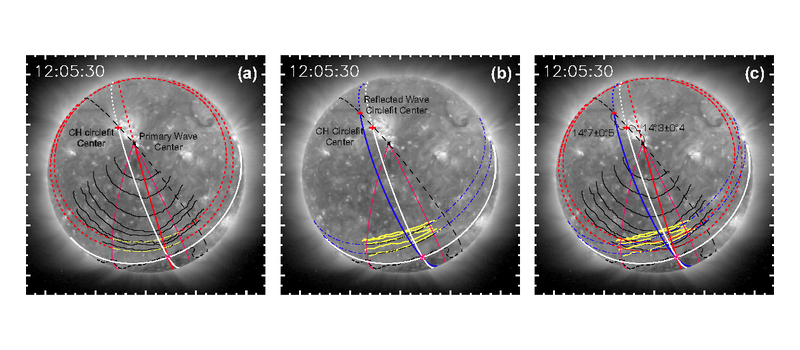Reflection of Coronal Global Waves
From RHESSI Wiki
(Created page with "{{Infobox Nugget |name = Nugget |title = Reflection of Coronal Global Waves |first_author = Ines Kienreich |second_author = Hugh Hudson |publish_date = January 13, 2014|previous_...") |
(starting 217) |
||
| Line 28: | Line 28: | ||
We make use of the EUV images obtained by [STEREO-A] and by [PROBA2]; this | We make use of the EUV images obtained by [STEREO-A] and by [PROBA2]; this | ||
| - | epoch put STEREO-A almost at [quadrature], i.e. with a nearly | + | epoch put STEREO-A almost at [quadrature], i.e. with a nearly orthogonal view of the events. |
| + | The events were at the extreme limb as viewed from near the Earth. | ||
Thus the analysis of the wave dynamics can delve into the three-dimensional | Thus the analysis of the wave dynamics can delve into the three-dimensional | ||
structure, something only possible with STEREO. | structure, something only possible with STEREO. | ||
| - | Figure 1 shows an overview. | + | Figure 1 shows an overview of one of the events, T12:18; this was the only one for which a radio type II burst was reported (but, as can be seen in the [http://sprg.ssl.berkeley.edu/~tohban/browser/?show=grth1+qlpcr+gbmo+rms4a&date=20110127&time=120124&bar=1 Browser] summary of the radio observations, all three events had intense type III bursts. |
| + | This may or may not be relevant! | ||
[[File:217f1.png|800px|thumb|center|Fig. 1: | [[File:217f1.png|800px|thumb|center|Fig. 1: | ||
| - | Overview of | + | Overview of Wave No. 2, as seen by STEREO-A. The black lines are wave fronts from the disturbances emanating in the active region; the yellow lines show the reflections detected at the boundary of the south polar coronal hole. The other lines show meridians, propagation great circles, and circular fits to the boundary of the coronal hole. |
]] | ]] | ||
| - | + | These events are unusual in several ways. | |
| + | '''First''', they arise from quite trivial flare events in NOAA 11149, just at the NW limb on the date of observation - a minor sunspot group. | ||
| + | '''Second''', there were three events in one day, quite unusual; '''third''', they were closely [homologous], a striking property; fourth, the waves impinged almost at right angles to the magnetic boundary of the south polar coronal hole. | ||
| + | Probably without these factors working so well together, we would not have been able to carry out such a detailed analysis of the wave reflection. | ||
== References == | == References == | ||
Revision as of 11:09, 9 January 2014
| Nugget | |
|---|---|
| Number: | 217 |
| 1st Author: | Ines Kienreich |
| 2nd Author: | Hugh Hudson |
| Published: | January 13, 2014 |
| Next Nugget: | TBD |
| Previous Nugget: | Flare Coronal Rain |
| List all | |
Introduction
Flares and CMEs can excite large-scale waves in the corona, observable by many techniques with our excellent modern data. These global waves can in extreme cases produce the [chromospheric] signature that we call a [Moreton wave], but since Uchida's early interpretative workin terms of MHD wave propagation, we have understood the chromospheric wave to be a consequence of the global wave itself. Controversy has raged on and off regarding the relationships between the globalwaves and their causes (flare [blast wave]? or CME [bow wave]?). In this Nugget we do not discuss the exciters, but only the wave propagation.The particular events studied (see Ref. [1]) occurred on 27 January 2011: SOL2011-01-27T08:50 [B1.1], T12:18 [B1.9] , and T20:03 (C1.5), all from the same active region. This is already interesting, because these are minor flares.The RHESSI Browser shows them, highlighting the 12:18 event because of its association with a radio [type II] event.
This Nugget describes the subsequent propagation of the global waves and reports a new property: the apparently [specular reflection] of the wavesat a distant magnetic domain wall.
Observations
We make use of the EUV images obtained by [STEREO-A] and by [PROBA2]; this epoch put STEREO-A almost at [quadrature], i.e. with a nearly orthogonal view of the events. The events were at the extreme limb as viewed from near the Earth. Thus the analysis of the wave dynamics can delve into the three-dimensional structure, something only possible with STEREO. Figure 1 shows an overview of one of the events, T12:18; this was the only one for which a radio type II burst was reported (but, as can be seen in the Browser summary of the radio observations, all three events had intense type III bursts. This may or may not be relevant!

These events are unusual in several ways. First, they arise from quite trivial flare events in NOAA 11149, just at the NW limb on the date of observation - a minor sunspot group. Second, there were three events in one day, quite unusual; third, they were closely [homologous], a striking property; fourth, the waves impinged almost at right angles to the magnetic boundary of the south polar coronal hole. Probably without these factors working so well together, we would not have been able to carry out such a detailed analysis of the wave reflection.
References
- [1] STEREO-A and PROBA2 Quadrature Observations of Reflections of Three EUV Waves from a Coronal Hole
| RHESSI Nugget Date | 13 January 2014 + |
| RHESSI Nugget First Author | Ines Kienreich + |
| RHESSI Nugget Index | 217 + |
| RHESSI Nugget Second Author | Hugh Hudson + |